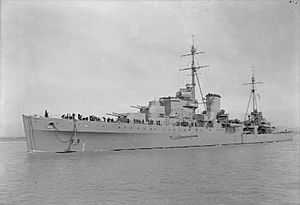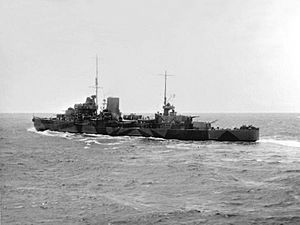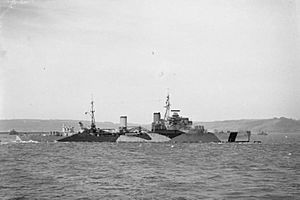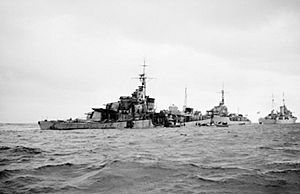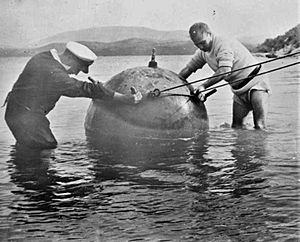Corfu Channel incident facts for kids
The Corfu Channel incident was a series of three events in 1946 involving ships from the Royal Navy in the Corfu Channel. It is seen as one of the first disagreements of the Cold War.
First, Royal Navy ships were shot at by Albanian forts. Later, British ships hit mines. Finally, the Royal Navy cleared mines from the channel, even though it was in Albanian waters, which Albania complained about to the United Nations.
These events led to a court case called the Corfu Channel case. The United Kingdom took Albania to the International Court of Justice. The Court decided that Albania had to pay £844,000 to the UK. This amount would be worth about £24.4 million today. Because of these incidents, Britain stopped talks with Albania in 1946. They wanted to start official diplomatic relations, but these were only restored in 1991.
Quick facts for kids Corfu Channel incident |
|||||||
|---|---|---|---|---|---|---|---|
| Part of the Cold War | |||||||
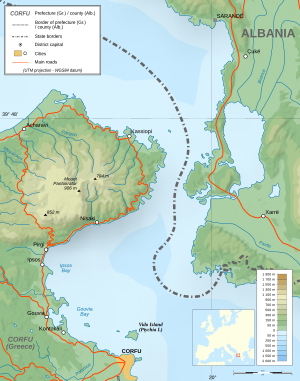 Corfu Channel Incident |
|||||||
|
|||||||
| Belligerents | |||||||
| Commanders and leaders | |||||||
| Units involved | |||||||
| Casualties and losses | |||||||
| none | 84 killed 42 wounded 2 destroyers damaged (one of them beyond repair) |
||||||
Contents
What Happened: A Timeline of Events
First Incident: Shots Fired
The incidents began on May 15, 1946. Seven Royal Navy ships, including HMS Orion and HMS Superb, sailed through the Corfu Channel. They had checked the strait beforehand to make sure it was clear.
While they were passing, Albanian artillery from coastal forts fired at them. The shells missed, and the British warships could not shoot back. No one was hurt, and the ships were not damaged.
Britain officially demanded an apology from the Albanian government. Albania did not apologize. Instead, they said the British ships had entered their waters without permission. Albania warned that all ships needed to give notice before passing through the Corfu Channel. The British government said they would not give notice. They also threatened to shoot back if their ships were fired on again.
Second Incident: Ships Hit Mines
The second incident was much more serious. On October 22, 1946, a Royal Navy group of ships was ordered to go north through the Corfu Channel. This group included the cruisers HMS Mauritius and HMS Leander, along with some destroyers. Their orders were to see how Albania would react to their right of "innocent passage" (passing through international waters peacefully). The crews were told to fight back if attacked.
The ships were sailing close to the Albanian coast in an area they thought was free of mines. HMS Mauritius was in front, with HMS Saumarez following closely. HMS Leander was about three kilometers away, with HMS Volage.
Near the bay of Saranda, just before 3 p.m., the destroyer HMS Saumarez hit a mine. It was badly damaged. The destroyer HMS Volage was ordered to tow HMS Saumarez south to a harbor in Corfu.
Around 4:16 p.m., while towing, HMS Volage also hit a mine and was heavily damaged. The front parts of both ships were completely blown off. Bad weather in the channel made towing very difficult. All ships had to sail backward. After twelve hours, all ships finally reached Corfu harbor.
Eighty-four sailors died, and forty-two were injured in this incident. About 32 to 43 of the dead were from the crew of HMS Saumarez. HMS Saumarez was too damaged to be repaired. HMS Volage could be fixed. Albanian coastal guns did not fire during this incident. An Albanian Navy ship came to the scene flying the Albanian flag and a white flag (a sign of peace).
It was later believed that Yugoslavian Navy ships had laid these mines around October 20, 1946, at Albania's request. The British Minister of Pensions gave full military pensions to those injured and to the families of those who died.
Third Incident: Mine Clearing Operation
The third and final incident happened on November 12–13, 1946. The Royal Navy carried out another mine-sweeping operation in the Corfu Channel. This operation was called Operation Retail.
The operation took place inside Albanian waters, but without permission from the Albanian government. One goal was to find the mines as proof that the British were acting in self defence by trying to clear dangers to ships. A French naval officer was there as an observer. An aircraft carrier (HMS Ocean), cruisers, and other warships provided protection.
Twenty-two contact mines were found and cut from their underwater anchors. The mines were placed in a way that showed they were put there on purpose, not just scattered randomly. Two of the mines were sent to Malta for closer study.
It was found that the mines were from Germany. However, they had no rust or sea growth. They were also freshly painted, and their cables were recently oiled. This suggested the minefield was laid shortly before HMS Saumarez and HMS Volage hit them. Pieces of the mine from HMS Volage confirmed they were similar to the ones found in Malta.
After this third incident, Albania, led by prime minister Enver Hoxha, sent a message to the United Nations. They complained that the Royal Navy had entered Albanian waters without permission.
What Happened Next
On December 9, 1946, Britain sent a note to the Albanian government. They accused Albania of laying the mines and demanded money for the damage from the May and October incidents. Britain wanted a reply within fourteen days. They said if Albania refused to pay, the matter would go to the UN Security Council.
Albania replied on December 21, 1946. They denied Britain's claims. They said the whole event was planned by countries that did not want good relations between Albania and Britain. They also claimed that ships from Greece and other countries had recently entered the area where the mines were found.
Britain was not happy with this answer. They eventually took their case to the International Court of Justice (ICJ). They had failed to get the Security Council involved. This was the very first case decided by the ICJ.
In December 1949, the court ordered Albania to pay Britain £843,947 (or US$2,009,437). The court said that even if Albania didn't lay the mines, they should have known about them. This was because the minefield was so close to their coast. Therefore, Albania failed to warn the British about the danger. The Court also disagreed with Britain's argument that they were acting in self-defense. It ruled that the mine-clearing operation by the Royal Navy during Operation Retail was illegal because Albania had not given permission.
The Albanian government refused to pay the money ordered by the Court. In response, the British government held onto 1,574 kilograms of Albanian gold. This gold had been stolen by the Axis powers from Albania during World War II. It was stored in the vaults of the Bank of England. A group from the US, UK, and France had given the gold to Albania in 1948 after it was found by the Allies.
When the Cold War ended, the People's Socialist Republic of Albania no longer existed in 1992. Official relations between Britain and Albania began again on May 29, 1991. Soon after, on May 8, 1992, Britain and Albania announced they had reached an agreement about the Corfu Channel case. They both said they regretted the incident of October 22, 1946. The gold was finally returned to Albania in 1996 after long talks. Albania agreed to pay US$2,000,000 in delayed reparations.
Enver Hoxha, Albania's leader at the time, later wrote in his memories that the British made up the whole event. He claimed it was an excuse to send naval patrols near Saranda. Hoxha also wrote that Albania "never planted mines in the Ionian Sea." He suggested the mines were either from World War II or were put there by the British themselves to explode. He also criticized the Royal Navy's presence, saying, "There was no reason for these ships to be sailing along our coast, they had not notified us about such a movement." Hoxha called the events "an unprecedented provocation toward our country."
In 2009, a team of US and Albanian researchers announced they found what they believe are parts of the front of HMS Volage. They found them in the Corfu Channel about fifty meters underwater. Dishes, shoes, and ammunition found nearby support this idea. In 2013, an article in Archaeology Magazine discussed these new discoveries. Auron Tare, Director of the Albanian Center for Marine Research, found film footage that seemed to show HMS Volage very close to the shore when the incident happened. James P. Delgado, from the National Oceanic and Atmospheric Administration (NOAA), also confirmed that the wreck was likely HMS Volage. He said the electrical wiring matched, and the stacked dishes showed the ship sank quickly.
International Law and the Case
The International Court of Justice's decision in this case set an important rule. It helped decide if breaking another country's territory is ever allowed. The United Kingdom argued it was right to enter Albanian waters on November 12 and 13, 1946. They said they needed to gather evidence for their case.
See also
- USS Monocacy incident
- General Sherman incident
- HMS Hunter


